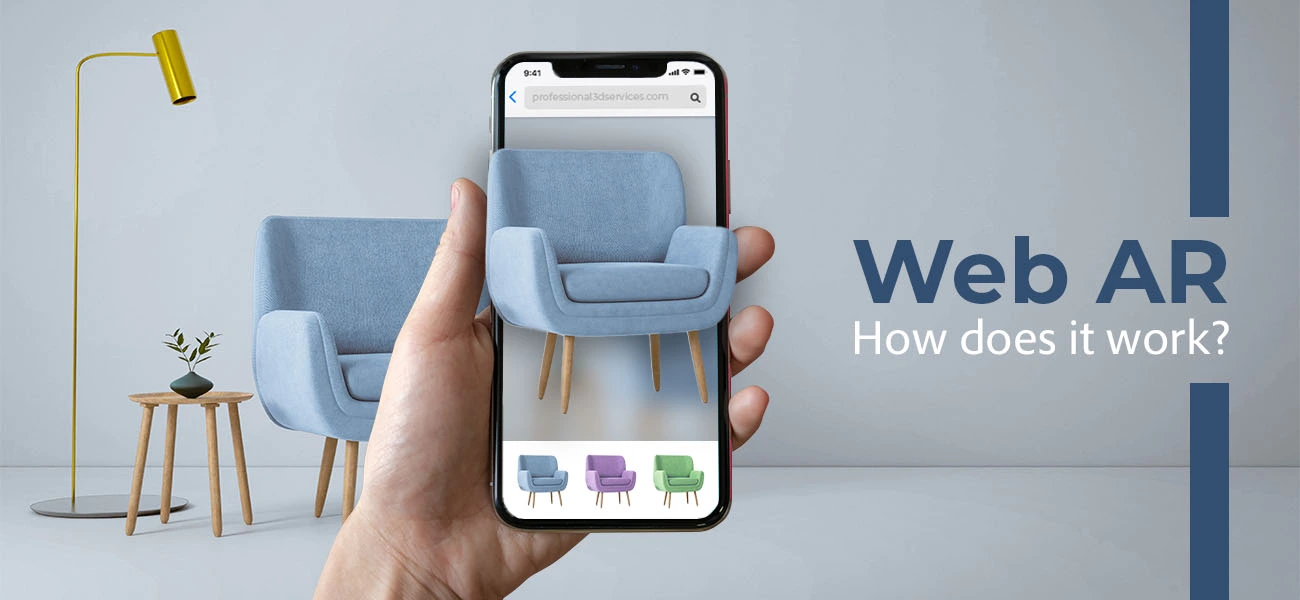Web-Based Augmented Reality (AR): How Does It Work?

Web-Based Augmented Reality (WebAR) refers to the integration of augmenting real-world experiences into web browsers without installing any downloadable applications. This can be accessed through the URL or QR code that is accessible through smart devices. This includes the device's camera, gyroscope, accelerometer, and magnetometer. It allows them to interact with the AR experiences directly on the web.
In this comprehensive guide, you will learn everything about web-based augmented reality (AR) and how it works. Also, you will learn more in detail about
- How does Web-based AR function
- How does the technology produce so accurate and flawless 3D projections
- How Web-based AR and App-based AR differs from each other?
- Which industries and sectors have adapted Web-based AR and benefitted from the technology?
What is the importance of AR visualization?
From the name itself, we can figure out that AR is something that actually “augments” or “adds to” the real world around us. This groundbreaking technology aims to enhance the viewing and hearing experience of the users. It achieves this by blending virtual objects (even music) with the real world.
AR can be used both through the browser (browser-based AR) and by downloading applications (app-based AR). Our today’s topic under discussion is web-based augmented reality or AR in browser.
The easy accessibility of web augmented reality gives a seamless shopping experience to the users. It is also a major growth contributor to the industries leveraging it. In a nutshell, not only it boosts user experience but also boost ROI. So without any further delay, let’s dive into the main theme.
How does Web-based AR work?
The creation of Web AR was mainly aimed at making the technology accessible through any browser of the user's choice. So commonly, JavaScript is used in AR web development, which is compatible with major web browsers such as Google Chrome, Microsoft Edge, Mozilla, Safari, Opera, etc. Apart from this, web AR is also designed for old and dated handsets.
Using AR in the browser is easy. All you have to do is open the camera of your smartphone, and either scan a QR code or click on the link that is provided and you are all set! But the real game starts after this.
-
Induction of trigger to start the process
A trigger is induced as soon as you scan the QR code or click on the given URL. This trigger prompts the interaction between the AR content and the web browser and you enter the webpage.
-
Camera streaming
Immediately after entering the webpage, they ask for the camera access. Granting access to the camera starts preparing to blend the real scene with the virtual object. This is called “camera streaming”.
-
3D scene and camera synchronization
When the camera turns on after granting access, the webpage activates the 3D modeled object that was previously inside it and starts adjusting it with the scene within the camera frame.
-
Six Degrees of Freedom (6DoF)
Six Degrees of Freedom is required to track the position and movement of the 3D object so as to make it fit into the real world scene of the camera frame.
-
The final result
After proper motion and position tracking, the 3D object (may be any object you are planning to buy, like a piece of furniture) is fit into the real scene to show you what you expected.
Note: The 3D models that are augmented in the real life scenes are stored and managed by the CMS or Content Management System of AR also called AR Cloud.
Web AR vs AR Application
Web-based AR and app-based AR both have their own uses and fan-base but there is a key difference which still makes web-based AR a preferred choice.
For using an app-based AR, users have to download a dedicated application on their devices. Every software application requires a lot of hit and trial to improve and many times users have to answer questions on the features (which are for the developers to make improvements on the application) after using the app every time. Downloading an app uses a lot of space in the device’s memory plus many find it “waste of time” to answer questions after using an app and skip them.
On the other hand, users don’t have to go through these additional steps for using web-based AR. All they have to do is click on the link or the given QR code, allow camera access and enjoy! This enhances the user-experience and results in greater conversion rates. Users feel more connected to the brand, and even refer the name to their peers which manifests better reach as we all search for easy ways to get our job done.
Applications of web AR : Top 6 industries to consider
Several industries make use of web AR in their business models for maximizing their profit margins. They are:
- Fashion industry in modeling, designing and beauty products try on.
- Medical Sector for research and learning.
- Education sector for classroom teaching.
- Manufacturing industry.
- Defense training.
- Entertainment industry.
To sum up
Web AR is an amazing advancement in AR technology which has helped many sectors market their products, train students and employees, make advancement in the medical field and so on.
3D modeling and 3D rendering deserve special recognition when it comes to using AR for marketing or shopping products. If you want to boost your brand name through custom made 3D product models on your website you just need to get hold of the right 3D modeling firms offering 3D modeling for AR.
Reach us anytime to get your quote!
Contact UsFrequently Asked Questions (FAQ)
WebAR is short for Web-based Augmented Reality. Here are the different types of web AR available are
- Scene view
- Asset view
- Surface tracking
- Marker tracking
Yes, AR can work without an app. This means users do not need to download the app to visualise the augmented reality experience. You can experience it either by clicking on the link or scanning through smart devices.
Native AR is an app based AR experience that provides the fastest and most reliable experiences for users. It is easy to download the app and can tap into your device's functions directly.
WebAR is an app-less AR experience that can be used by either clicking the link or scanning the QR code. Users can get straight into the content on the web offering the immersive and interactive digital experience.
The AR cloud is called the digital copy of the spatial environment. Developers can build AR experiences using this technology framework rather than starting from scratch. It provides geopositioning, image recognition, and machine learning. In addition, it offers faster internet and mobile data connections.

